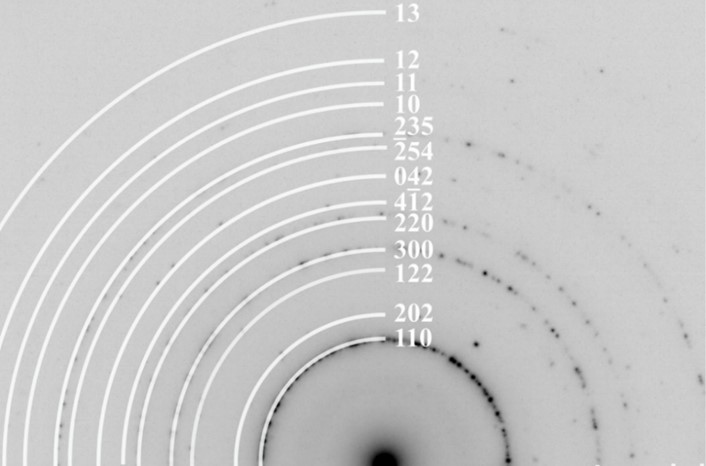
The crystallization of thin Sb2Te films with vacuum annealing and an electron beam
Abstract
Keywords
Full Text:
PDFReferences
Xiao Z, Kisslinger K, Dimasi E, Kimbrough J. The fabrication of nanoscale Bi2Te3/Sb2Te3 multilayer thin film-based thermoelectric power chips. Microelectron Eng. 2018;197:8–14. doi:10.1016/j.mee.2018.05.001
Champier D. Thermoelectric generators: A review of applications. Energy Convers Manag. 2017;140:167–181. doi:10.1016/j.enconman.2017.02.070
Vieira EFM, Figueira J. Enhanced thermoelectric properties of Sb2Te3 and Bi2Te3 films for flexible thermal sensors. J Alloys Compd. 2019;774:1102–1116. doi:10.1016/j.jallcom.2018.09.324
Haidar SA, Gao Y. Deposition and fabrication of sputtered bismuth telluride and antimony telluride for microscale thermoelectric energy harvesters. Thin Solid Films. 2021;717:138444(1–9). doi:10.1016/j.tsf.2020.138444
Voraud A, Seetawan T, Kumar M. Experimental and theoretical study of thermoelectric properties of rhombohedral GeSb5Te10 thin films. MSEB. 2019;250:114439(1–5). doi:10.1016/j.mseb.2019.114439
Ding X, Yang X. Theoretical analysis and simulation of a tunable mid-infrared filter based on Ge2Sb2Te5 (GST) metasurface. Superlattices Microstruct. 2019;132:106169(1–6). doi:10.1016/j.spmi.2019.106169
Cheng L, Yuan Y. Linear and nonlinear optical properties modulation of Sb2Te3/GeTe bilayer film as a promising saturable absorber. Results Phys. 2019;13:102282(1–7). doi:10.1016/j.rinp.2019.102282
Khusayfan, N. M. and Khanfar H. K. Characterization of CdS/Sb2Te3 micro/nano-interfaces. Optik. 2018;158:1154–1159. doi:10.1016/j.ijleo.2018.01.010
Liu G, Wu L. The investigations of characteristics of Sb2Te as a base phase-change material. Solid State Electron. 2017;135:31–36. doi:10.1016/j.sse.2017.06.004
Liu B, Song Z, Feng S, Chen B. Characteristics of chalcogenide nonvolatile memory nano-cell-element based on Sb2Te3 material. Microelectron Eng. 2005;82(2):168–174. doi:10.1016/j.mee.2005.07.007
Ding K, Chen B, Rao F. Boosting crystallization speed in ultrathin phase-change bridge memory device using Sb2Te3. Mater Sci Semicond Process. 2021;136:105999(1–6). doi:10.1016/j.mssp.2021.105999
Hu J, Lin C. Cr-doped Sb2Te materials promising for high performance phase-change random access memory. J Alloys Compd. 2022;908:164593. doi:10.1016/j.jallcom.2022.164593
Wang G, Shen X. Improved thermal stability of C-doped Sb2Te films by increasing degree of disorder for memory application. Thin Solid Films. 2016;615:345–350. doi:10.1016/j.tsf.2016.07.059
Yang C-H, Chiang K-C, Hsief T-E. Nonvolatile floating gate memory characteristics of Sb2Te–SiO2 nanocomposite thin films. Thin Solid Films. 2013;529:263–268. doi:10.1016/j.tsf.2012.07.135
Liu F, Wang G, Zhang Y, Li C. Improved multi-level storage performance by insulator-metal transition of In2S3-doped Ge2Sb2Te5 films. Ceram. 2019;45:24090–24095. doi:10.1016/j.ceramint.2019.08.116
Lotnyk A, Hilmi I, Behrens M, Rauschenbach B. Temperature dependent evolution of local structure in chalcogenide-based superlattices. Appl Surf Sci. 2021;536:147959(1–8). doi:10.1016/j.apsusc.2020.147959
Jiang K, Lu Y. GeTe/Sb4Te films: A candidate for multilevel phase change memory. MSEB. 2018;231:81–85. doi:10.1016/j.mseb.2018.10.002
Kampmeier J, Weyrich C. Selective area growth of Bi2Te3 and Sb2Te3 topological insulator thin films. J Cryst Growth. 2016;443:38–42. doi:10.1016/j.jcrysgro.2016.03.012
Bera S, Behera P. Weak antilocalization in Sb2Te3 nano-crystalline topological insulator. Appl Surf Sci. 2019;496:143654(1–6). doi:10.1016/j.apsusc.2019.143654
Buga SG, Kulbachinskii VA. Superconductivity in bulk polycrystalline metastable phases of Sb2Te3 and Bi2Te3 quenched after high-pressure–high-temperature treatment. Chem Phys Lett. 2015;631:97–102. doi:10.1016/j.cplett.2015.04.056
Choi M, Choi H, Ahn J, Kim YT. Material design for Ge2Sb2Te5 phase-change material with thermal stability and lattice distortion. Scr Mater. 2019;170:16–19. doi:10.1016/j.scriptamat.2019.05.024
Nolot E, Sabbione C. Germanium, antimony, tellurium, their binary and ternary alloys and the impact of nitrogen: An X-ray photoelectron study. Appl Surf Sci. 2021;536:147703(1–21). doi:10.1016/j.apsusc.2020.147703
Peng L, Li Z. Reduction in thermal conductivity of Sb2Te phase-change material by scandium/yttrium doping. J Alloys Compd. 2020;821:153499(1–7). doi:10.1016/j.jallcom.2019.153499
Meng Y, She Q. Uniform silicon carbide doped Sb2Te nanomaterial for high temperature and high speed PCM applications. J Alloys Compd. 2016;664:591–594. doi:10.1016/j.jallcom.2016.01.036
Pandey SK, Manivannan A. Direct evidence for structural transformation and higher thermal stability of amorphous InSbTe phase change material. Scr Mater. 2021;192:73–77. doi:10.1016/j.scriptamat.2020.10.014
Delavignette P, Vook RW. Method for measuring the thickness of thin bent foils in transmission electron microscopy. Phys Stat Sol. 1963;3:648–653. doi:10.1002/pssb.19630030406
Kooi BJ, De Hosson ThM. On the crystallization of thin films composed of Sb3.6Te with Ge for rewritable data storage. J Appl Phys. 2004;95(9):4714–4721. doi:10.1063/1.1690112
Song SA, Zhang W, Jeong HS, Kim J-G, Kim Y-J. In situ dynamic HR-TEM and EELS study on phase transitions of Ge2Sb2Te5 chalcogenides. Ultramicroscop. 2008;108. doi:10.1016/j.ultramic.2008.05.012
Ryu H, You Y, Paek MC, Kang K. Microscopic behavior of Sb in chalcogenide materials for crystallization process. Mater Sci Eng A. 2007;449:573–577. doi:10.1016/j.msea.2006.02.421
Kim YT, Kim ET, Kim CS, Lee JY. Phase transformation mechanism of In–Sb–Te through the boundary reaction between InSb and InTe. Phys Stat Sol. 2011;5(3):98–100. doi:10.1002/pssr.201004515
DOI: https://doi.org/10.15826/chimtech.2023.10.1.11
Copyright (c) 2022 Anton A. Yushkov, Vladimir Yu. Kolosov

This work is licensed under a Creative Commons Attribution 4.0 International License.
Chimica Techno Acta, 2014–2025
eISSN 2411-1414
Copyright Notice






